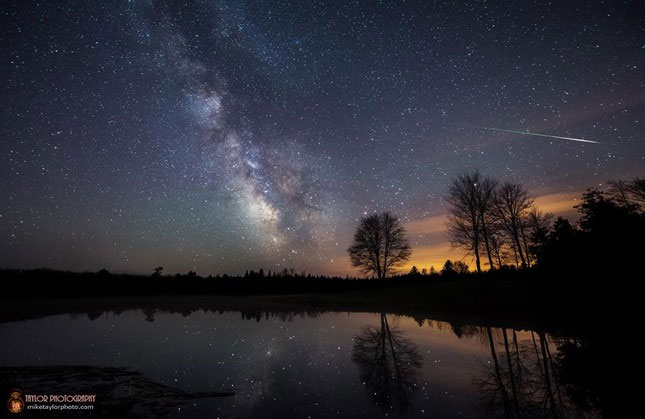According to the Hanoi Astronomy Association (HAS), in May 2022, astronomy enthusiasts can observe fascinating phenomena in the sky. Notably, there will be meteor showers and a total lunar eclipse occurring at the beginning and middle of the month.
May 1: New Moon
The Moon will be aligned with the Sun from the perspective of Earth, making it invisible in the night sky. This event will occur at 3:30 AM (Vietnam time). This will be the best time of the month to observe faint celestial bodies like galaxies and star clusters, as they will not be affected by moonlight.
May 6-7: Eta Aquarid Meteor Shower

An Eta Aquarid meteor in the May sky. Photo by: Mike Taylor
The Eta Aquarid meteor shower is an above-average meteor shower, reaching up to 60 meteors per hour at its peak. Most meteors will be observable in the Southern Hemisphere. In the Northern Hemisphere, the rate will only reach about 30 meteors per hour.
The Eta Aquarid meteor shower is formed from the dust particles of Halley’s Comet – an object known and observed since ancient times.
The Eta Aquarids typically occur annually from April 29 to May 28, with this year’s peak on the night of May 6 into the early morning of May 7. The brightness of the nearly full moon will obscure most meteors, except for the brightest ones. However, if you are patient, you might still catch a few beautiful meteors.
The best places to observe are dark locations after midnight. The meteors tend to radiate from the constellation Aquarius but can appear from anywhere in the sky.
May 16: Full Moon
The Moon will be opposite the Sun as viewed from Earth, and the side facing Earth will be fully illuminated. This event will occur at 11:15 AM (Vietnam time).
This full moon is referred to as the Flower Moon by ancient Native American tribes because it is the time when spring flowers are most abundant. It is also known as the Corn Planting Moon and the Milk Moon.
May 16: Total Lunar Eclipse

Total lunar eclipse. Photo by: Hoàng Quốc Phương (HAS)
A total lunar eclipse occurs when the Moon completely passes through the Earth’s shadow. During this type of eclipse, the Moon gradually darkens and then takes on a rusty or blood-red hue.
This lunar eclipse will be visible across North America, Greenland, the Atlantic Ocean, parts of Northern Europe, and West Africa (not observable in Vietnam).
May 30: New Moon
The Moon will again be aligned with the Sun from the perspective of Earth, making it invisible in the night sky. This event will occur at 6:32 PM (Vietnam time). This will again be the best time of the month to observe faint celestial bodies like galaxies and star clusters without the interference of moonlight.


















































